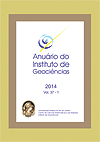Palynology, palaeofloristics and palaeoclimate aspects of late pleistocene sediments in the Guandu River Hydrographic Basin, Rio de Janeiro, Brazil
DOI:
https://doi.org/10.11137/2014_1_104_114Abstract
For presenting great morphological diversity, pollen grains, especially from angiosperms, can be used to determine stratigraphic sequences, relate geographically separated regions and reconstitute the paleoenvironment. Since 1970's, palynological studies on quaternary sediments have been conducted in Brazil, registering vegetation changes and climatic variations that occurred through this geologic period. Palynological analyses on sediments from Guandu river hydrographic basin are presented aiming to reconstitute the previous vegetation, understand its evolution and infer the paleoclimate during the late Pleistocene. For decades, the area has been suffering deep physiognomic changes due to extractive activities, characterizes by the Piranema Sand District. The flood trenches, resulting from such mining activity, enabled the withdrawal of a muddy sedimentary package, containing organic matter, along a columnar profile on Santobaia Sand Pit. The deposit was divided into five levels and all submitted to the standard methodology in chemical treatment. Geochronological analysis appointed a time period between 42.500 and 35.200 À 340 years BP. Palynological data evidenced that, despite the cold and dry weather, distinctive of this glacial period, humidity level was sufficient for the establishment of a vegetation throughout the studied chronological interval. Locally, a flooded forest subjected to occasional fluvial overflows was present, as well as a dry lowland vegetation, in areas out of reach of floods. Palynomorphs indicating the formation of a permanently waterlogged site were not observed. Regionally, a hillside forest was inset with a low pollen record, but always present. These three plant formations coexisted during the considered time period, and the dimension of each one was directly influenced by the Guandu river basin's hydrographic conditions.Downloads
Download data is not yet available.
Downloads
Published
2014-06-01
How to Cite
Misumi, S. Y. (2014) “Palynology, palaeofloristics and palaeoclimate aspects of late pleistocene sediments in the Guandu River Hydrographic Basin, Rio de Janeiro, Brazil”, Anuário do Instituto de Geociências. Rio de Janeiro, BR, 37(1), pp. 104–114. doi: 10.11137/2014_1_104_114.
Issue
Section
não definida
License
This journal is licensed under a Creative Commons — Attribution 4.0 International — CC BY 4.0, which permits use, distribution and reproduction in any medium, provided the original work is properly cited.















